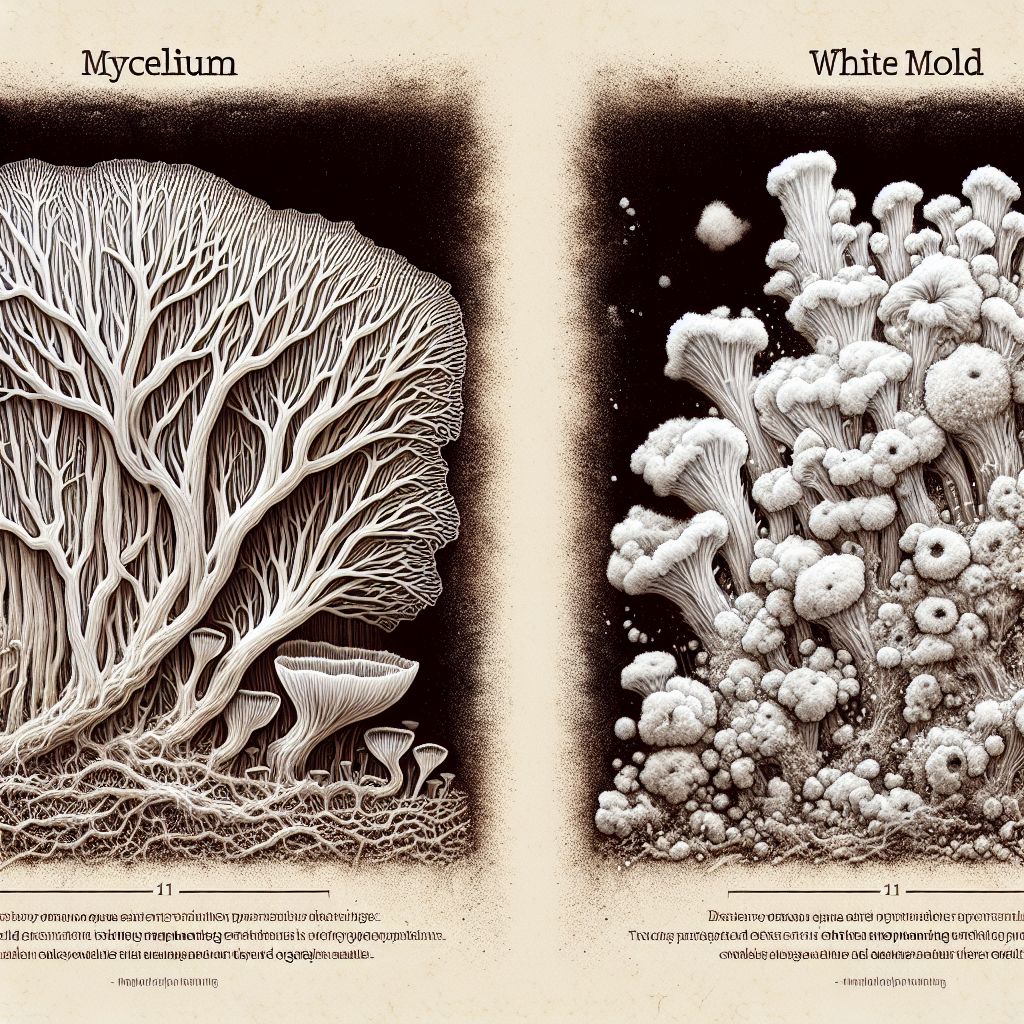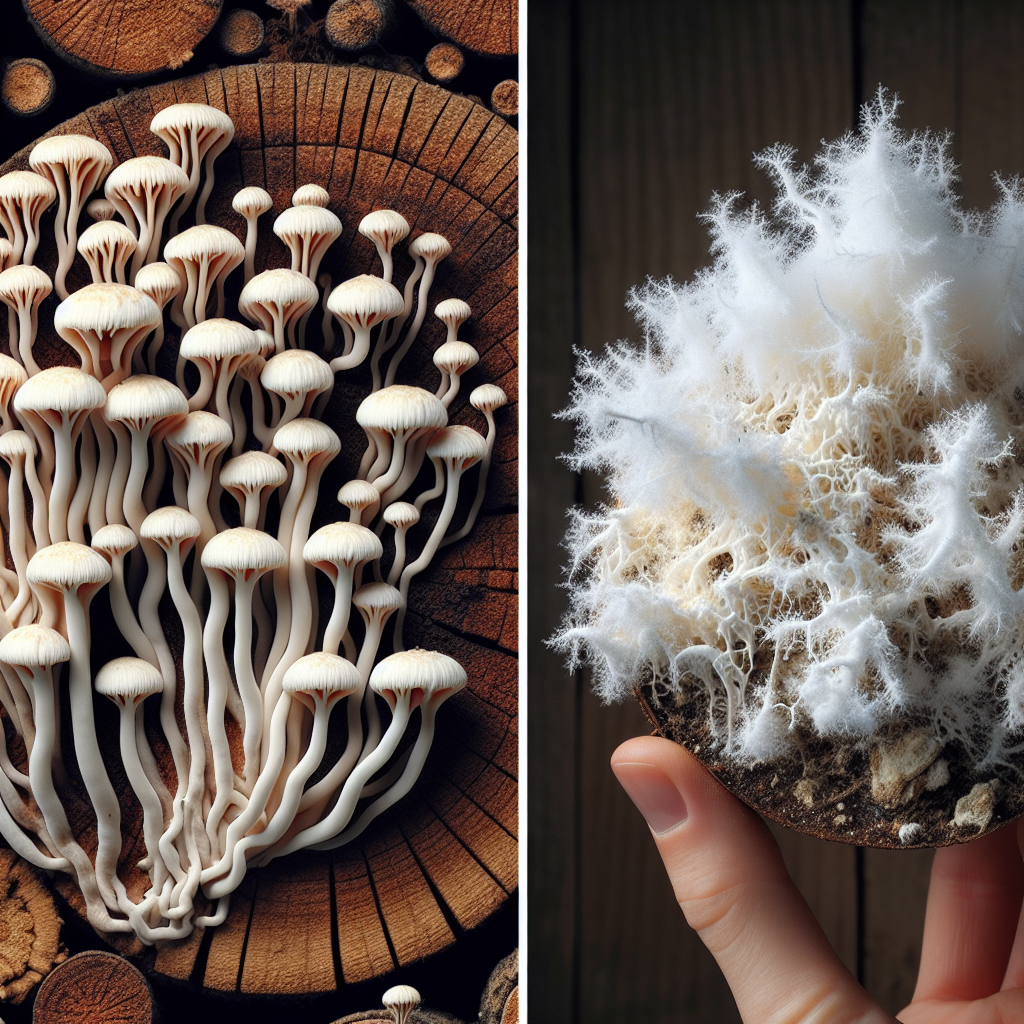In the field of mycology, it’s indispensable to distinguish between seemingly analogous entities, like mycelium and white mold. The article, “Understanding the Differences: Mycelium vs White Mold”, enlightens you about these two distinct entities, their characteristics, their biological significance, and how to differentiate one from the other. Despite their apparent resemblance, these two terms represent unique aspects of fungal growth and engaging in this article will help you comprehend those nuances.

Defining Mycelium
Basics of Mycelium
Mycelium refers to a network of filamentous structures known as hyphae, producing fungal colonies. Produced by fungal spores, mycelium is often invisible to the naked eye in its initial stages. This underground network plays a crucial role in organic decomposition, therefore promoting nutrient cycling.
Understanding the Biology of Mycelium
The biology of mycelium is fascinatingly sophisticated and complex. Whole networks can permeate over vast areas, weaving through the soil, wood, and other organic substrates. Each hypha behaves as an individual cell, able to fulfill the lifecycle of the fungus independently, and yet, when working collectively as mycelium, the capacity for growth, decomposition, and reproduction is vastly amplified.
Common Environments for Mycelium
Mycelium commonly resides in soil and other nutrient-rich environments. It can exist in various substrates, both organic and inorganic, and often thrives in damp, dark, and warm environments. Decaying wood, compost heaps, gardens, and agricultural fields are natural habitats for mycelium.
Identifying Features of Mycelium
Visible Characteristics of Mycelium
Generally, mycelium manifests as a white or off-white fuzzy or thread-like structure. It is often spread out in a spider-web configuration across or within the substrate in which it resides. These characteristics, however, can differ depending on the type of fungi producing the mycelium, and its environmental conditions.
Identifying Mycelium Under the Microscope
Under a microscope, mycelium presents as an intricate network of hyphae. Each hypha appears as a thin, tube-like structure often filled with spores. Mycelium’s hyphae may appear curving and branching, forming an interwoven mesh.
How Mycelium Interacts With its Environment
Mycelium is crucial in breaking down organic matter and facilitating nutrient cycling in ecosystems. It interacts with its environment through a process known as mycelial decomposition. Here, the hyphae secrete enzymes that break down complex organic material into simpler substances, which are subsequently consumed by the fungus and cycled back into the environment.
Defining White Mold
Basics of White Mold
White mold, also known as sclerotia, is a type of pathogenic fungus. Characterized by its fluffy white appearance, it can damage or kill many agricultural crops, ornamental plants, and can even generate health issues in humans and animals when present in high amounts.
Understanding the Biology of White Mold
White mold usually begins its life as a hard black structure known as a sclerotium, which grows and germinates under optimal conditions into the white mycelium visible to the naked eye. It relies on a process known as parasitism to survive, absorbing nutrients from living organisms and potentially causing those organisms harm in the process.
Common Environments for White Mold
White mold prefers cool, moist environments which have a relative high humidity. It can be found in various environments including soils, on plants, and even in buildings with moisture problems.

Identifying Features of White Mold
Visible Characteristics of White Mold
The appearance of white mold can often be mistaken for mycelium due to its fluffy, web-like structure. However, it is usually distinguished by the evidence of its fruiting bodies, which appear as tiny white round structures.
Identifying White Mold Under the Microscope
Under the microscope, white mold exhibits a network of hyphae similar to mycelium. However, you may also observe sclerotia, which are dense, darkly pigmented survival structures that differentiate white mold.
How White Mold Interacts With its Environment
White mold interacts with its environment through parasitism. It can rapidly colonize and degrade its host, causing disease and death in plants.
The Life Cycle: Mycelium vs. White Mold
How Mycelium Reproduces
Mycelium reproduces asexually by releasing spores from structures called sporangiophores or fruiting bodies. When these spores land in a suitable environment, they germinate into hyphae, which group together to form a new mycelium network.
How White Mold Reproduces
White Mold follows a similar reproductive strategy, but its spores often come from sclerotia, which develop into fruiting bodies under optimal conditions. The fruiting bodies then release the spores.
Similarities and Differences in the Life Cycles
Both mycelium and white mold reproduce through spore dispersion. However, while mycelium focuses on breaking down organic materials, white mold practices parasitism, feeding on living organisms.
The Effects: Mycelium vs. White Mold
Effects of Mycelium on Plants
Mycelium’s relationship with plants is generally beneficial, helping in nutrient uptake and protection against certain pathogens. However, if the mycelium belongs to a pathogenic fungus, it can cause plant disease and death.
Effects of White Mold on Plants
White mold, on the other hand, is inherently pathogenic and often results in significant crop loss in agriculture and damage to ornamental plants.
The Impact on Human Health
Mycelium, for the most part, does not affect human health negatively unless it forms part of a harmful mold. Certain types of molds can cause a range of health issues from allergies to more severe conditions like asthma. White mold spores can be harmful if inhaled in large quantities, potentially causing allergies and other respiratory problems.
Control and Management: Mycelium vs. White Mold
How to Control Mycelium in Cultivation
Mycelium in cultivation can be beneficial. However, it’s important to recognize the signs of a potentially harmful fungus among your crops. Regular monitoring and the application of organic fungicides can help control any undesired growth.
How to Control White Mold in Cultivation
Management of white mold typically involves the modification of environmental conditions. This may include improving soil drainage, adjusting plant density, or applying antifungal agents.
Preventive Measures for Both
Preventive measures for managing both mycelium and white mold include maintaining cleanliness, monitoring humidity levels, and practicing crop rotation where applicable.
Mycelium and White Mold in Food
Role of Mycelium in Food and Beverage Industry
Mycelium plays a significant role in the food and beverage industry, particularly in the production of bread, beer, wine, and soy sauce. It also helps in the creation of food products like tempeh and certain types of cheese.
Impacts of White Mold on Food, and Food Products
White mold, however, is a sign of spoilage in most food and can cause their degradation. Some cheeses, like Camembert and Brie, do utilize white molds beneficially, but this is a controlled setting where a specifically benign type of white mold is used.
Safe Levels of Mycelium and White Mold in Food
While mycelium may be used in food production, its presence usually indicates spoilage. Similarly, any presence of white mold signals spoilage and potential danger if consumed, unless it is part of a deliberately controlled fermentation process, such as in some types of cheese.
The Benefits: Mycelium vs. White Mold
Potential Benefits of Mycelium
Mycelium has many potential benefits. It contributes to rich soil fertility, aids in the process of germination, and has roles in pharmaceuticals due to its bioactive compounds.
Potential Benefits of White Mold
While mostly a detriment in many industries, white mold has its specific uses. In cheesemaking, for example, it’s necessary for the production of certain types of cheese like Brie and Camembert.
Possible Applications for Each
Potential applications for mycelium extend beyond food to include the fields of medicine, soil conservation, and even as a component in sustainable building materials. White mold, however, has fewer broad applications given its propensity to destroy crops and other plant life.
Future Research: Mycelium vs. White Mold
Research Needs on Mycelium
Exploring the full potentials of mycelium could be beneficial, particularly in pharmaceutical applications, biodegradable materials, and eco-friendly alternatives to common materials.
Research Needs on White Mold
Research on white mold needs should focus on effective management strategies and prevention methods, especially in the field of agriculture.
Upcoming Innovations in Relevant Fields
The future holds potential exciting applications and innovations in both domains. For mycelium, this includes expanded use in pharmaceuticals and sustainable materials. For white mold, it will likely focus on methods of control and eradication, potentially using biocontrol agents to limit its spread without adversely affecting the environment.
